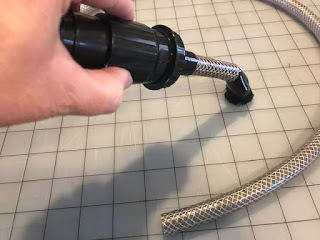"Junior" isn't a run-of-the-mill piece of sculpture or one you would expect to find in the special collections of a university library, yet it's part of a large collection of correspondence, manuscripts, photographs, and DVDs at the University of New Hampshire in Durham. The collection was amassed by university alumna Betty Hill and her husband Barney, a couple who claimed they were abducted by aliens. Even the dress Betty was wearing that fateful night is part of this extensive other-worldly collection.
Betty and Barney Hill lived in Portsmouth, New Hampshire. Betty (1919-2004) was a social worker with a degree from the University of New Hampshire, and Barney (1923-1969) was a postal worker. The couple were catapulted into the international spotlight when, in September 1961, they claimed to have been abducted by aliens in the White Mountains of New Hampshire. The two were returning home to Portsmouth from a trip to Montreal, Canada, when, as they were driving in the middle of the night, they saw lights approaching from the sky. What followed is said to be the first well-documented, feasibly legitimate UFO abduction in history. The couple claimed that they saw bipedal humanoid creatures in the window of a large spacecraft that landed in a field, after which they had no recollection of the next two hours. They returned home to Portsmouth unable to explain the two missing hours. Both Betty and Barney had physical evidence from the night before, including Betty’s torn and stained dress, Barney’s scraped shoe, and a broken binocular strap, but neither of them had any memory of these things having happened. [1]

Photograph of Betty and Barney Hill, Betty and Barney Hill Papers, 1961-2006, MC 197, Milne Special Collections and Archives, University of New Hampshire Library, Durham, NH, USA.
Betty and Barney engaged Ohio artist Majorie Fish to create the bust of an alien based on a description Betty provided. In fact, thirty-four letters between the Hills and Fish exist in the university's collection. Called "Junior," the bust is a popular artifact at the university, as you might imagine. It measures just 13-inches tall and is made out of an unknown synthetic material -- possibly a type of fiberglass -- that is soft enough to yield when gently pressed. Unfortunately, Betty accidentally dropped the bust at some point, resulting in several cracks in the neck and the back of the head, all radiating from a sizable loss. Scotch tape was also present in an earlier attempt to support the cracks.
"Junior," the alien, before conservation.
It was time for the university to send it to the Conservator's Studio for repair and conservation. The goal of the treatment was to repair the head and make it stable again for display.
To improve the appearance, and to remove particulate materials damaging to the fabric, the entire surface of the artifact was vacuumed with low suction and a small brush attachment. The tape on the surface of the bust was mechanically removed.
A mount was then designed to 1) prevent the top-heavy bust from tipping over and 2) provide internal structure to lessen the possibility of the cracks becoming larger. The mount consisted of a solid redwood base to act as a counterweight. A vertical post was attached to the new base, padded with Ethafoam the diameter of the head's interior and secured to the base. The bust was placed over the padded post. When tightened, the bust was both invisibly and reversibly attached to the base. With this method, the cracks were given slight pressure to ensure they would not increase. All wooden components in the mount’s design were sealed with several coats of “Spar” Varnish, which is conservation approved.
The Rest of Betty and Barney's Amazing Story....
About a year after their abduction, Betty and Barney sought hypnosis therapy to help reveal to them the events of the two missing hours. Through many hypnosis sessions, both were able to recall what had happened and both had similar stories. Betty Hill, following her experience, became one of the most well-known voices in UFO research. The publicity she received from her abduction made her internationally famous. "Junior", the careful reconstruction of her abductor, became the most familiar face of alien visitors, inspiring internet memes and the beloved movie character, ET. She continued her research into UFOs for the remainder of her life, even after Barney’s sudden death in 1969. The Hills, though best known for their association with UFOs and their abduction, were also active civil servants in their seacoast New Hampshire community. Both were members of the NAACP and belonged to a local Unitarian church. Barney sat on a local board of the U.S. Civil Rights Commission. [2]
Footnotes
[1]
Betty and Barney Hill Papers, 1961-2006, MC 197, Milne Special Collections and Archives, University of New Hampshire Library, Durham, NH, USA.
[2] Ibid.
Resources
Betty and Barney Hill Papers, 1961-2006, MC 197, Milne Special Collections and Archives, University of New Hampshire Library, Durham, NH, USA.



































